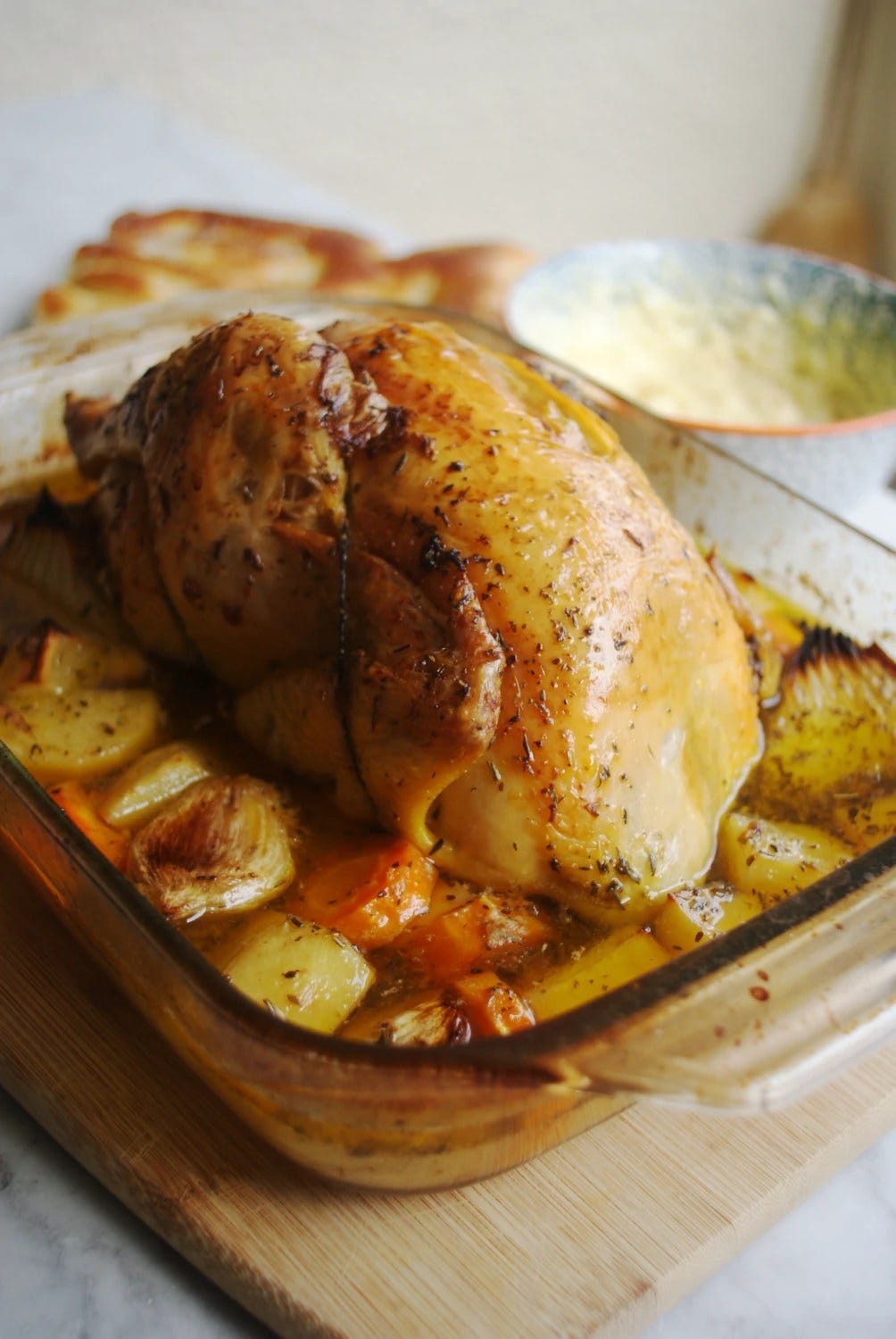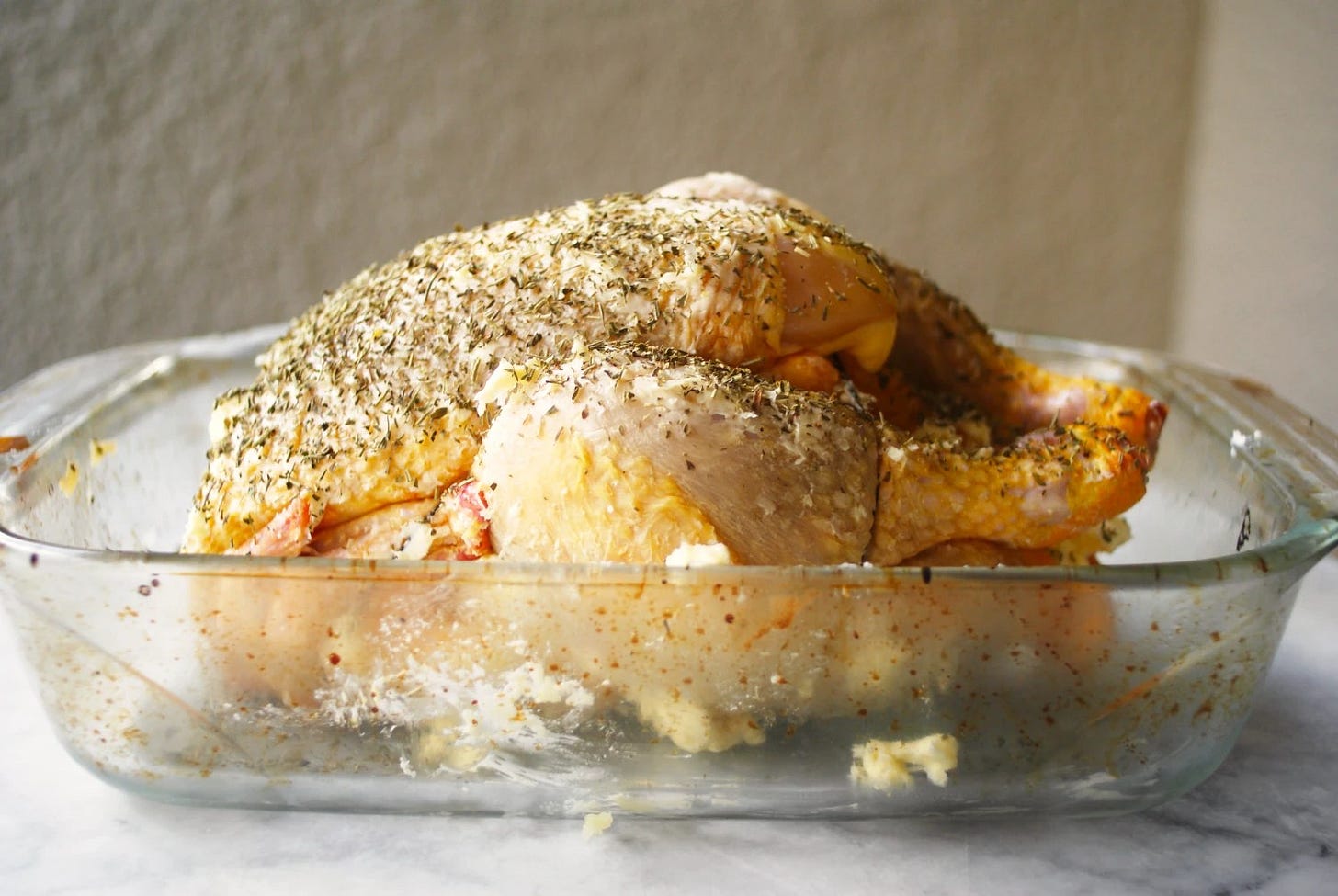It all starts with a greasy massage in garlic butter. When I say “it”, I’m not referring to what I get up to on a Friday night, I mean a French roast chicken.
French roast chicken is much the same as other countries’ claims on roast chicken, but for some reason, there is something alluring about that particular descriptive word “French”. French perfume, French wine, French kisses – there’s something about it that makes me want to wiggle my eyebrows like an unimaginative teenager and retreat to my Pinterest board to pin arty photos of French things.
Or maybe it’s thanks to France’s skill at twirling rotisserie chickens. The word itself is French, coming from the Parisian shops of no doubt dangerous rotisserie machinery around the 15th century churning out spit-roasted birds. Now, trailers of rotisseried birds park up at markets here in Toulouse, the chickens sizzling and dripping, and I race past every time I’m late for yoga (which is always), my slowing legs seemingly in secret communication with my stomach, begging me to bail on that day’s downwards dog and to enjoy the chicken-grease smeared human instead.
So, is the logic that if the French can man 40 rotating chickens, surely the homecooked French roast chicken will be flawless?
There are no rules to the French roast chicken, as is the case with most roasts (except, just gonna elbow in my awkward pet peeve here, Yorkshire puddings must be served with roast beef only). Every French family on those Sunday lunchtimes would have mastered their own cooking techniques, sacred as a family religion. However, coming hand in hand with that essence of French high quality, your chook needs to be well-reared. Label Rouge is the symbol of free-range, corn-fed, happy chickens swanning around what is essentially a country holiday home. The meat will be firm and plump and incongruously heavy, but as with French culinary traditions, the ingredients speak for themselves.
Despite there being no “rules” as such, there are still some “recommendations” that signify this roast as a French roast chicken:
Poaching
Instead of inflicting the chicken to the dry heat of the oven sauna, the French frequently poach it in a relaxing hot tub of stock. Stock or water is poured all around the chicken in the baking dish before it all is packed away for a little steam in the oven. Vegetables including carrots, potatoes, garlic cloves, and wedges of onion are scattered around the chicken, and are submerged by the liquid and chicken juices, drinking it in until velvety soft and saturated.
Regular basting rules out that bronzed skin, as crisp as a Dorito, but the meat is so fat and succulent, even that notoriously dry breast meat takes on a plump makeover, pouting like lip fillers. Hydration is the key, folks. And if crispy chicken skin is your goal in life, splay that chicken out under the grill, like a paunchy man on a tanning bed, for a quick sear in the last 20 minutes.
Butter
In France, there is an unspoken consensus on the sheer pointlessness of reduced fat. The French are notorious for their alleged nonchalance for taboo, and I suppose that also includes an apathy towards diet culture. That chicken can be slathered in butter, massaged in any and all orifices, and as it melts in the heat, it drips into the surrounding stock like a savoury, buttery irrigation system.
And of course, if there is butter, why not add garlic? Garlic butter is never a bad idea, especially on the mild, tender, juicy meat of a chicken. Gaylord used smoked garlic which we’d been kindly donated by Jessica after she and her husband had been accosted by an overly-enthusiastic market seller, cramming bulbs into their arms, and expecting them to plant extra should the need for garlic arise. Instead, she gave the excess to us and fellow tour-guide Jenn, her handy human garbage disposals. Subtly smokey, that garlic was massaged into butter to slather all over that chicken like a face mask.
Sides
The French roast chicken has different sides to my family’s British roast chicken – for us, there’s without fail a gravy boat brimming with chicken juice gravy, roast potatoes and a medley of vegetables, all cooked with varying techniques, to brighten the plate. In Gaylord’s experience of the roast chicken, there are those aforementioned carrots, and then according to him the onion and potato also count towards your five a day, so the veg ends there.
One carb is never enough for a French dish, so a baguette is always present (or in our case, baguette and focaccia) especially as there needs to be something to soak up all that stock on your plate, along with mayo – ideally homemade – and a jug full of the broth, shimmering with pools of chicken fat and butter.
The mayo is for dipping purposes. I was raised to eat with a good grasp on my knife and fork, but a French roast chicken leaves cutlery to idle unused. Instead, you need to grapple with that chicken leg, dunking it in mayo before lifting it to your mouth to gnaw. Meanwhile, the garlic is squidgy-soft and squeezed out of its papery prison to be mixed into the mayo or spread liberally over anything that stays still long enough.
Sot-l’y-laisse
Clinging like barnacles to the back of the chicken, at the top of the thighs, are the prized morsels – the chicken oysters. The French know them, not for their resemblance to molluscs, but for being the best part of the whole bird, the most tender and juicy mouthful of meat. Their name in French “sot-l’y-laisse” means “a fool leaves them”. So, serve your French roast chicken with aplomb, with the two oysters as the crown jewels.
The Politics of the French Roast Chicken
Roast chicken is universally accepted as the taste of home. Everyone’s got a tale about it. It is the meat your mum slung in the oven because it was so low-maintenance she knew she’d have time to interrupt World War III starting in the next room. Chicken is the flavour of humble domesticity – roast beef may come with some very dapper Yorkshire puddings (if I have my way), but it is the roast found at all pubs across the UK, morphing it into anonymity. Roast chicken, on the other hand, bridges family divides and cultures to be served as the staple Sunday lunch, particularly in France.
A picturesque farmhouse comes to mind when thinking of French roast chicken, so unassuming and rustic, a meal put together purely for the sheer pleasure of eating it. That said, the roast chicken will never rise beyond these trappings. No matter how many swanky chicken shops we build and frequent, the seasonings and dressings the chefs shower the meat with, this bird will forever be held back by the apron strings – and therefore a pretty boring reputation.
Food writers have tried to run with roast chicken to see how far they can go. Ella Risbridger uses mustard, ginger, rosemary, thyme, chilli and chilli salt, garlic, and lemon in a cheerful attempt to remodel the bird, but surely all those flavours would mask what we’re actually eating it for? The memories that chicken conjures.
Here, the French roast chicken is evidently a “madeleine de Proust” – a taste of childhood. It is mine too, and one that I don’t eat enough of. So, instead of confining roast chicken to the staple Sunday lunch, let’s make it a spontaneous meal, one that needs only as much planning as buying the chicken, and also the food of celebration. I even requested it for my birthday this year and after Gaylord – my slave for the day – had emerged for the kitchen, armed with a groaning dish of chicken, buttery garlic cloves, and homemade mayo, we managed to eat the entire bird in two meals. And an upcoming Easter French roast chicken has a lovely ring to it.
If roast chicken is always going to be the food of home, maybe this is something dating apps should keep in mind as a tag or bio prompt. Find a love interest who can roast a chicken, be it a French one or beer canned or spatchcocked. While we’re all used to that sentiment that cooking is an expression of love, chicken is a flavour of home and personal to each diner. So, be selfish – find that perfect someone who can cater to your childhood cravings by roasting a chicken.
French Roast Chicken
Gaylord is the kind of cook to throw ingredients at a dish without any idea of their quantities (he laughed when I asked him how many carrots he used, then he realised I was being serious) so this definitive recipe certainly has room to manoeuvre!
We used smoked garlic but normal garlic will pack more of a punch of flavour so you may need less than we did. Taste as you go.
Chop your vegetables into relatively big chunks so that they don't dissolve into mush during the long roast.
Also, if you're looking for a mayonnaise recipe, I have one here (feel free to omit the wholegrain mustard).
Prep Time: 20 minutes
Cook Time: 1 hour 30 minutes
Course: Dinner, Lunch, Main Course
Cuisine: French
Keyword: butter, chicken, garlic, stock
Servings: 4
Ingredients
1.5 kg chicken, free-range, ideally corn-fed
3-4 garlic cloves, smoked or normal
4 tbsp unsalted butter, softened
1 tbsp dried herbes de Provence
½ lemon
2-3 carrots, peeled, chopped into big chunks
2-3 potatoes, peeled, chopped into big chunks
1 onion, quartered (no need to peel)
4 garlic cloves, no need to peel
1 ltr chicken stock (you may not need it all as it depends on the volume of your baking dish)
Salt and freshly ground black pepper
Instructions
Preheat the oven to 200°C/180°C fan/400°F. Remove the chicken from the packaging but leave on the strings so that the chicken remains trussed and cooks more evenly. Place it in a baking dish with high sides, large enough to fit the chicken along with surrounding veg. Season the chicken generously with salt and some pepper.
Grate the garlic in a bowl and add the softened butter. Massage them together then smear it all over the chicken skin – it will be a wrestle but try your best! Sprinkle over the dried herbes de Provence then squeeze the lemon over the surface.
Arrange all the chopped carrots, potatoes, onion wedges and garlic cloves around the chicken and season them with a little salt. Pour over the stock until the vegetables are submerged, then put the dish in the oven to roast for roughly 1 hr 30 mins (30 minutes per 500g). Every 20 minutes, remove the dish and baste the chicken with the stock.
In the final 20 minutes of cooking, turn up the temperature to 220°C/200°C fan/430°F to colour the skin. Meanwhile, make a mayonnaise if you wish, and a green salad. At last, remove the chicken from the oven and leave it to sit for 5 minutes before carving to allow the juices to settle.
Don't forget to enjoy the chicken oysters and to serve your French roast chicken with bread!










Sounds delicious!
Guess what I saw in Moore Wilson? Yes! Boursin but sitting in that special cheese cabinet in the centre of the store, not just lying around. Obviously one needs to ask to buy....
Why have I never thought to rub my chicken with garlic butter? I'm absolutely doing that next time!